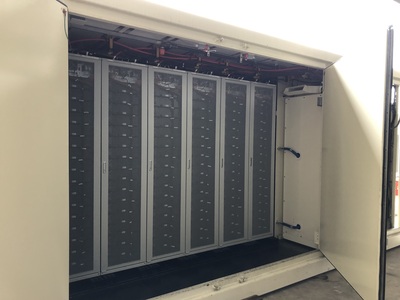This post was originally published on Sustainability Matters

The mining industry has come one step closer to sustainability thanks to an innovative idea from Australian company RUC Mining, which specialises in underground mining hoists.
Underground mining hoists, or winders, are powerful machines used to raise and lower minerals and materials in a mine shaft. They enable the efficient vertical transport of materials — thus avoiding the necessity for larger machinery and further costs.
While travelling upward, the hoists require a large amount of power, but this is not the case on the way down.
This led to a stroke of inspiration on the part of RUC Mining: what if energy generated on the way down could be stored, then used to power the upward journey?
The sustainability implications and broader contribution to the electric mine of the future were huge — but there was a technically complex and challenging task to figure out first.
RUC Electrical Manager Greg Bell set to work on making the idea a reality. He and the RUC team chose a couple of strategic partners, Rockwell Automation and Energy Power Systems Australia (EPSA), to create a fully integrated solution that could be rolled out to hoists across the globe.
The collaboration has led to the RUC team creating what they believe is the world’s first regenerative energy storage solution for underground mine winders, allowing these machines to run totally on their own stored energy rather than requiring a separate diesel generator.
RUC has now installed its RUCShaw 512 single-drum winder for the first time in an Australian mine. The winder is powered by 710 kW drives, has a hoist capacity of 5 m/s with 12-tonne line pull and operates with a design depth of 1600 m.
Handling the technical complexities
When hoisting a load up a mine shaft, electric motors consume energy. But when travelling downwards, they have the potential to become generators.
“Most mine hoists use a brake resistor pack with a cooling fan to deal with the heat generated. But these packs create a single point of failure, and are application-specific, so they need recalculation if a variation in brake power is required,” Bell explained.
“Instead, we proposed for the generating power to be supplied back onto the incoming supply bus, to be absorbed by system loads.”
To make this solution a reality, Rockwell Automation provided its Active-Front-End (AFE) Powerflex 755TR regenerative variable speed drives, Low Voltage Motor Control Centres and GuardLogix controllers. It also provided ThinManager software for application management; FactoryTalk View Site Edition software for a complete real-time overview of HMI operations; network and security services; and product and technical support.
The RUC team chose Rockwell Automation to supply the regenerative variable speed drives for the regenerative energy storage solution.
The battery selected to store regenerative energy was a Cat PGS 1260 battery energy storage system (BESS) supplied by EPSA, which provided added redundancy through its parallel inverter and battery stack architecture.
“We have one operational project where we have implemented this solution with two hoist drives, and we are looking into incorporating this into future projects. We also see potential for this solution to be rolled out on new and existing mine shafts internationally,” Bell said.
Sustainability gains
RUC has estimated that during the initial installation over a 24-month period, the regenerative energy storage solution will achieve a reduction in diesel consumption of 1427 kL (saving approximately $2 million) and a reduction of 3.85 tonnes of CO2 output — the approximate equivalent to travelling 12,700 km in a petrol car.
It will also result in an approximate 42% reduction in greenhouse gas emissions from power generation.
“In addition to these strong sustainability benefits, the regenerative energy storage solution also reduces daily operating costs, reduces plant operating hours and maintenance requirements, and provides an additional level of redundancy to the power system that was not available in passive components such as load banks,” Bell said.
Striking out into the unknown
Not only did it require a complex integration of technologies, but the regenerative storage project involved a lot of industry firsts, so there was no existing template to follow.
“Some companies dislike being the first to do something, because there’s no guarantee it will work. But Rockwell was supportive from the start. They helped us select the right drives for powering our hoists and worked to integrate this seamlessly to achieve regeneration coordination with the battery,” Bell said.
“I can’t speak highly enough of the Rockwell technical team — they are some of the best engineers I’ve worked with. Another major benefit was the Rockwell vendor manuals and technical information. These are first-class documents, and the latest versions are all available online, which was crucial for training the workforce and working remotely. Revision control was taken out of my hands because we were always accessing the latest version,” he added.
Because power goes straight back to the battery with no heat loss, Bell said this type of solution could readily be scaled down to any energy application — even something like elevators.
“We have plans to use this technology more widely, because if you think about the electric mine of the future, vertical haulage delivers the most affordable, operable and achievable solution for transporting material out of the mine. The technology has great export potential, too, so we can showcase Australian innovation on a global scale,” he said.
Top image caption: RUC Mining’s regenerative energy storage solution for underground mine winders.





0 Comments